The Contrasens Cultural Association, as part of their TMcult project, organized two online classes with ambitious goals, namely Școala de Critică și Jurnalism de Artă [The School of Art Criticism and Journalism] and the course Mediere culturală și comunicare a culturii [Cultural mediation and communication], both developed to hone the skills of professionals just starting out (but not exclusively) in the field of art criticism and cultural mediation.
It was the School especially that piqued my curiosity, as it had been a long-standing wish of mine to take part in an art journalism class that would challenge me to think and would show me how to write to the point about art projects/events, that would show me what adapting your language and discourse to a target audience implies, and, last but not least, would offer me a clear analysis of how to approach and conceive a solid text about art.
For the course program, the Contrasens Cultural Association included multiple workshops led by specialists in the field with the goal of establishing a starting point for the participants, of giving them a picture of what well-documented, responsible, and, why not, stimulating writing can look like in presenting and analyzing an art project or artist. The School of Art Criticism and Journalism was therefore organized around a series of specific and thematic meetings (via Zoom): a Creative Writing workshop, led by Mona Dîrțu (Superscrieri), an interactive workshop on Critical Thinking and Storytelling, led by Alexandru Condrache (writer, researcher, trainer), the masterclass Scrierea despre artă între expertiză, scepticism și complexitate [Writing about art, between expertise, skepticism, and complexity], led by Bogdan Iacob (conf.univ.dr. at the University of Art and Design, Cluj-Napoca), the seminar Texte & Texturi. Mesajul, forma și diseminarea criticii de artă [Texts & Textures. The message, form, and dissemination of art criticism], led by Diana Marincu (artistic director at the Art Encounters Foundation, curator, art critic), a workshop on Radio Art, led by Daria Ghiu (art critic, journalist), and mentoring sessions with Dana Sarmeș (director of the Contrasens Association, associate professor at the Faculty of Arts and Design at the West University of Timișoara).
The participants were selected following a national open call. They were mostly young professionals from the fields of journalism, philosophy, literature, and visual art (art historians, journalists, artists, curators, art critics, museographers, bloggers, content writers): Mălina Moncea, Mihai Toth, Vivien-Xenia Tinca, Miruna Moraru, Daniel Petru Gagiu, Lucia-Alexandra Brînaru-Mitrofan, Eduard Enache, Andreea Neag, Luminița Toma, Anastasia Gurschi, Aurelia Micoroi, Ionela-Andreea Ghețe, Etelka Tamás, Alexandra Mereuți, Gabriel Amza, Alice-Andreea Feraru, Andreea Dumitrescu.
Besides honing your professional skills and learning of new concepts, the purpose of the School also consists in applying the information learned in the workshops practically, specifically by contributing to ArtSens, a printed, cultural newspaper-type publication that sets out to document, throughout six issues, this year’s edition of the Art Encounters Biennial, which will take place between 1 September and 7 November 2021. The participants will visit the biennial and interact with the key people that contributed to its organization – curators, artists, cultural managers – in order to analyze and present Art Encounters as a cultural event and phenomenon to a wider audience (not just a specialized one). The aim of ArtSens is therefore to draw as many people as possible towards contemporary art by making journalistic and critical discourse accessible, and in the process become a companion publication to the biennial and a means of getting people in Timișoara interested in experimental art.
The School of Art Criticism and Journalism was an extremely dense experience in terms of information, having been exposed to a wide array of, at times complementary, visions of professionals with extensive experience both in their specific fields as well as in mentorship. The creative writing workshop led by Mona Dîrțu problematized the journalistic process and the potential approaches one can consider when conceiving texts and interviews with a pertinent, accessible language that should draw in the reader and make them read the article to the end. By engaging the participants in analyses and practical comprehension exercises on informative articles about art events in important publications (not exclusively dedicated to the visual arts), Mona Dîrțu showcased the structure and qualities of a memorable text that is easy to read for a wide target audience.
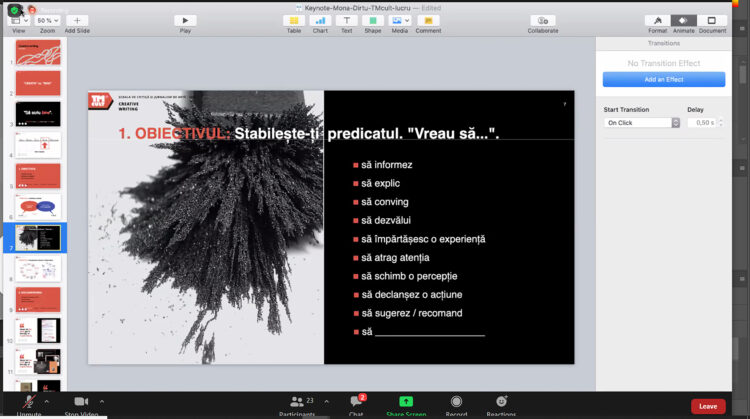
creative writing workshop led by Mona Dîrțu
The interactive workshop Critical Thinking and Storytelling, led by Alexandru Condrache, was an intense rollercoaster of ideas tossed back and forth, of polemics in the form of exercises in understanding concepts like the beautiful, the ugly, relativity, and truth (starting from art and then extrapolating to a more general level). And with the help of case studies – artistic and curatorial statements – Alexandru Condrache questioned the relevance and accessibility of a specific formal language and what must be filtered and adapted in order to produce a text about art that is directed to a wide audience. An important moment in the workshop was when we viewed the scene of the performance piece in the movie La grande bellezza, where the director makes a veiled reference to Marina Abramovic’s self-flagellation and the problematic way in which it can be seen. The participants were challenged to a discussion around how the artist portrayed is interviewed in the film, so as to highlight certain principles of tone, of how to approach your interlocutor, and of how to obtain pertinent information towards constructing an objective article. All in all, Alexandru Condrache held a dynamic and exciting workshop, initiating uncomfortable but necessary discussions for stimulating the participants’ critical thinking skills through applied exercises.
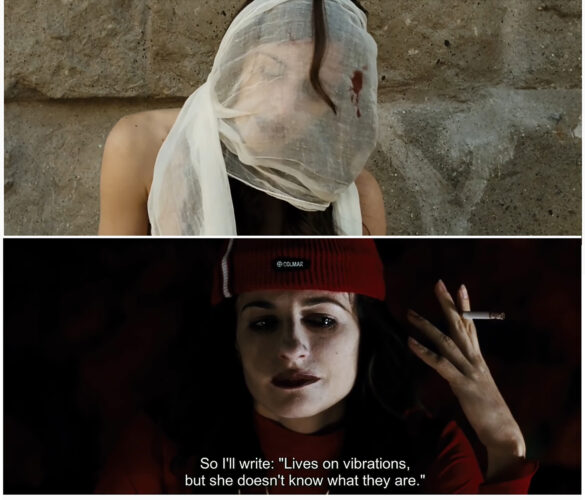
interactive workshop “Critical Thinking and Storytelling”, led by Alexandru Condrache (the scene from La Grande Bellezza)
Bogdan Iacob, in his masterclass Writing about art, between expertise, skepticism, and complexity, problematized the status of art writing, placing it at the intersection between craft (techne) and science (episteme). He also focused on the dynamics of the relation between image and discourse, offering possible approaches of how to potentialize a word to conjure an artistic image, while also discussing views on assuming expertise in curatorial, critical, and historical writing. The masterclass contained a lot of theory, incorporating notions of art history, critical theory, epistemology, philosophy, sociology, anthropology, with multiple references to authors like Nicolas Nassim Taleb, Arthur C. Danto, Guillaume Apollinaire, Clement Greenberg, Camille Paglia, Theodor Adorno, Hans-Georg Gadamer, Martin Heidegger, Immanuel Kant, Pierre Bourdieu, Sigmund Freud, etc. Bogdan Iacob thereby gave us an overview starting from the history of writing about art, the numerous theoretical perspectives and influences in the development of its discourse, ending with a potential projection of the ideal contemporary art writer. What this masterclass attempted to underline was the responsibility that lies behind the word, the documentation and responsibility that outline the writer’s point of view, and also the importance of being honest with yourself and with your reader in offering an expertise on an artistic vision, whatever it might be.
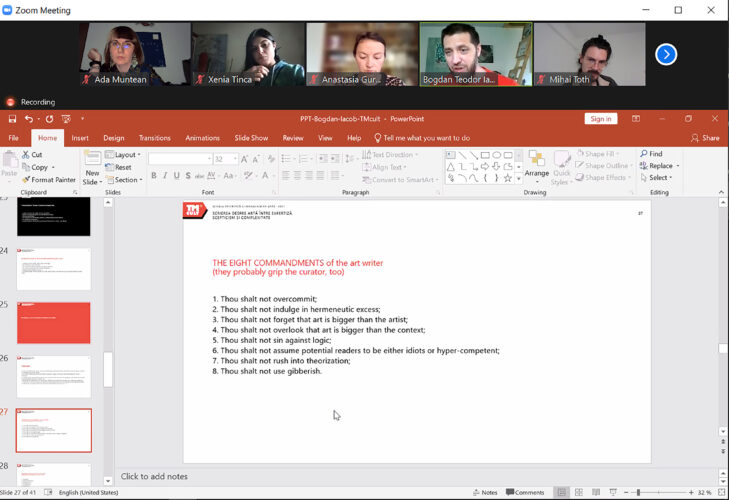
“Writing about art, between expertise, skepticism, and complexity” – masterclass by Bogdan Iacob
The seminar Texts & Textures. The message, form, and dissemination of art criticism, led by Diana Marincu, took shape as a series of exercises where we analyzed various types of texts by the art critics chosen depending on the public platform they were disseminated through: the cultural press, journals, exhibition catalogues, followed by writing exercises starting from the features of each type. Through discussions, Diana Marincu challenged us to decipher the specificity of curatorial discourse, while asking the participants to take part in comparative analyses, guided by case studies (artists’ profiles). In the end, they constructed an interview from two different perspectives: a formal, academic one (in terms of language) and an informal version, with a more accessible discourse. Diana Marincu’s seminar also focused on understanding how we classify texts about art: what is expected of an evaluation text (a review of an exhibition, a review of an art book, an interview, an essay), an explanation text (a curatorial text, a press release, a newsletter, a catalogue text), and what an experimental text entails (a manifesto, a letter, a lecture performance, a poem).
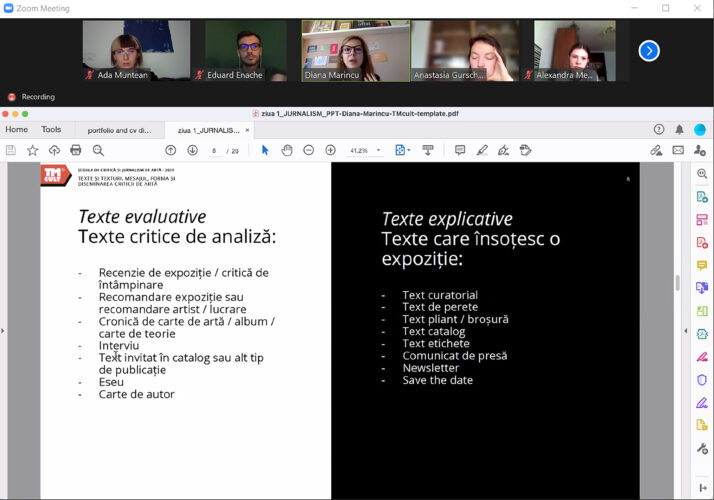
“Texts & Textures. The message, form, and dissemination of art criticism”, led by Diana Marincu
Daria Ghiu’s Radio Art workshop was organized as an inside look into radio, with three aims: acknowledging the historical importance of the radio and its evolution around four coordinates (propaganda, subversion, information, systematic education); learning the similarities and differences, in content and nuance, between the phrase radio art and art on the radio; and, finally, engaging in practical exercises involving field recording, planning an interview, and conceiving a radio documentary. Daria Ghiu emphasized the importance of sound, the specific features of this medium, and how it can be used to convey information and enhance atmosphere. Additionally, the workshop had two guests to be interviewed by the participants about their art practice: Traian Cherecheș and Irina Botea Bucan, both of whom have sound as a component in their works/installations. Each presented their work process and a selection of works from their portfolio, answering a series of questions from the course participants. Elena Vlădăreanu (as a guest as well) had also a short intervention, offering information about her activity as a journalist and specific advice on the process of putting together an interview. Daria Ghiu therefore achieved, in a limited amount of time, a dense and substantial investigation into the medium of radio, opening up an opportunity to learn to those who wished to explore radio as a means of communication.
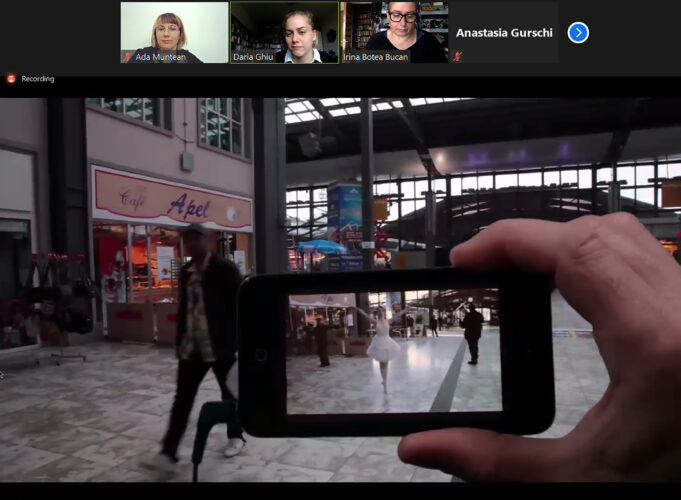
Radio Art workshop by Daria Ghiu (invited artist Irina Botea Bucan)
The School of Art Criticism and Journalism represented a remarkable effort from the organizers, instructors, and participants in making these online meetings a substantial exchange of knowledge and information in a time that is still problematic when it comes to running workshops, courses, and art activities that rely on human interaction. Through the TMcult project, the Contrasens Cultural Association managed to create a truly spectacular course, complex in the concepts discussed and ambitious in its goals, bringing together professionals of various levels of experience in a responsible endeavor of cultural construction.
TMcult® is a project of Asociatia Culturala Contrasens, co-financed by the AFCN.
Partners: The ArtEncounters Foundation, Centrul Cultural Clujean, Universitatea de Vest din Timișoara, Casa Artelor – Directia Judeteana pentru Cultura Timis, Minority & Local Media Development Center – MLMDC Novi-Sad
Translated by Rareș Grozea
POSTED BY
Ada Muntean
Ada is a Graduate of University of Art and Design in Cluj-Napoca and has a PhD in Visual Arts (2019), conceiving a research thesis entitled "The Human Body as Image and Instrument in Contemporary Art....


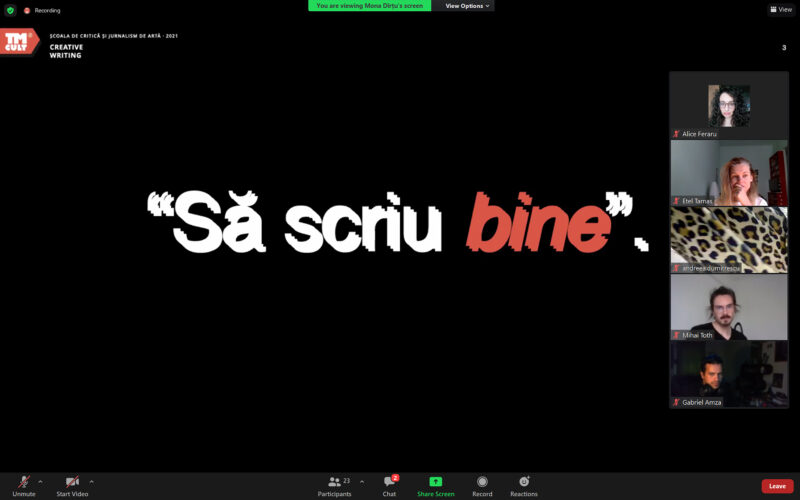
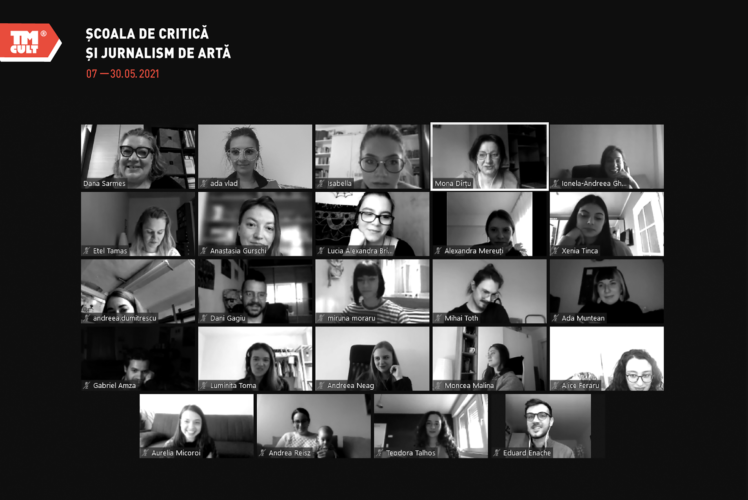
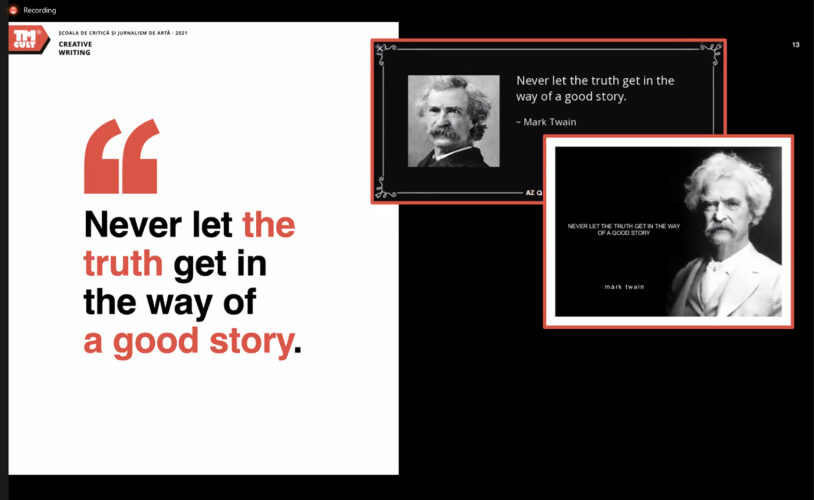
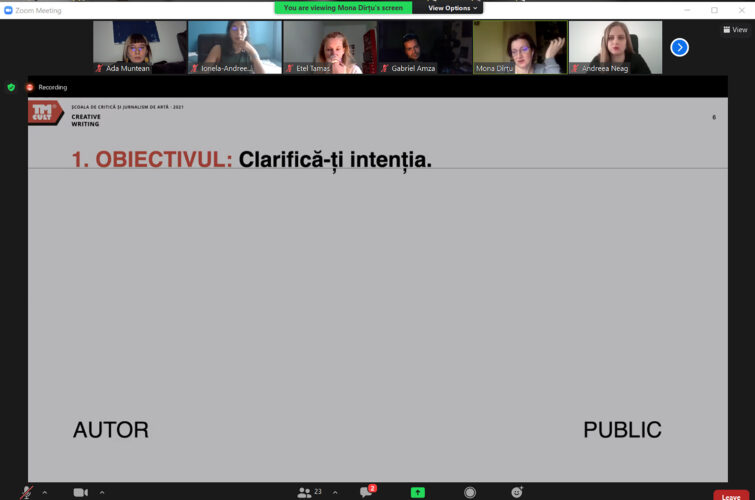
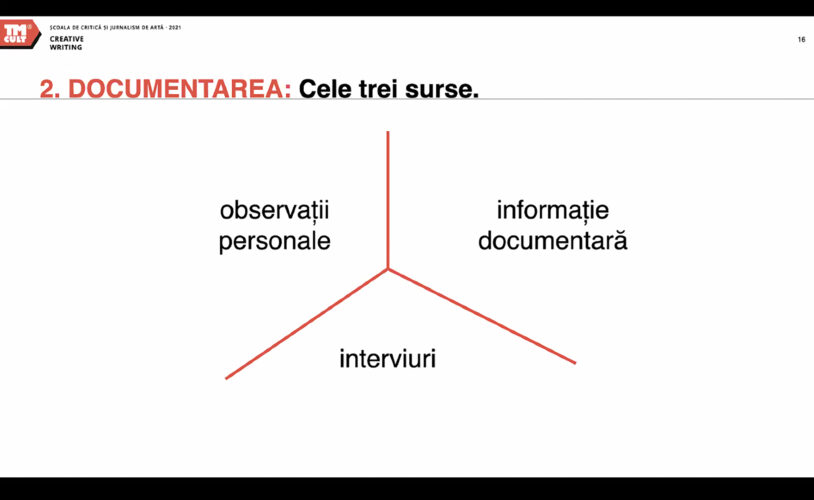
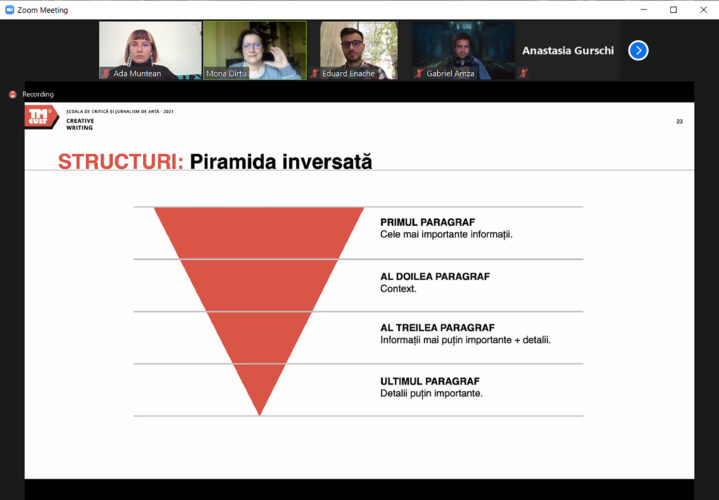
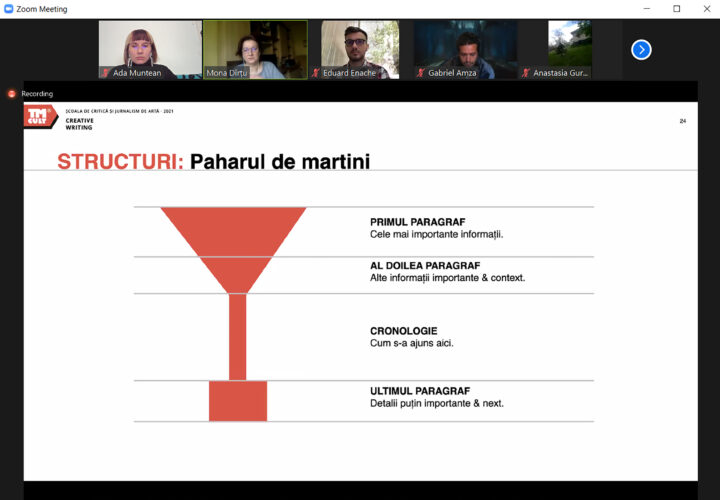
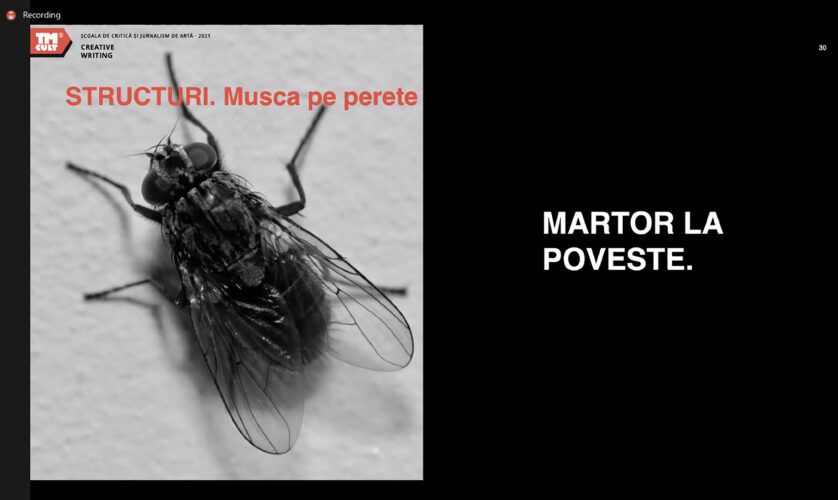
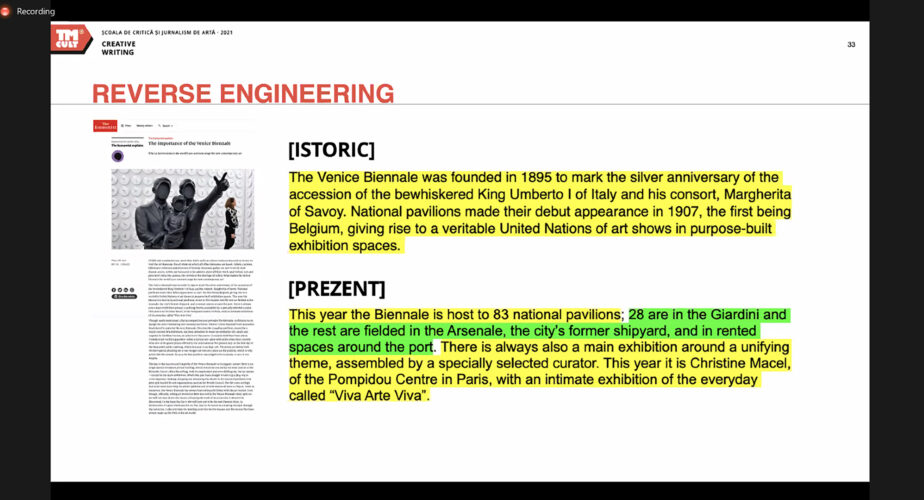
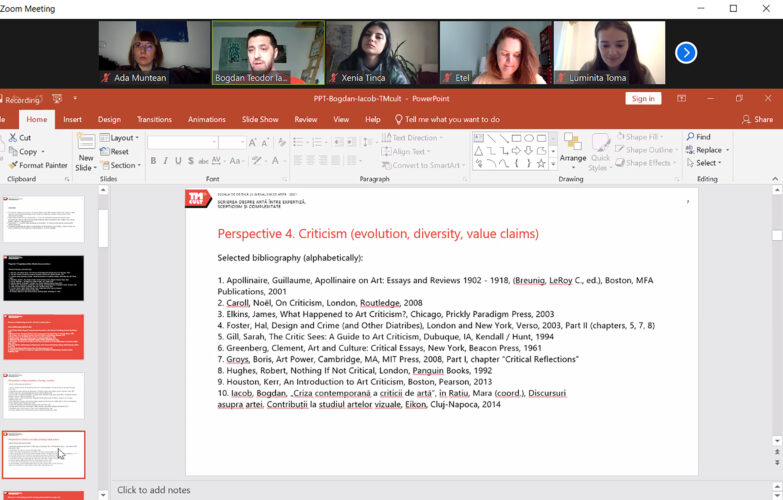
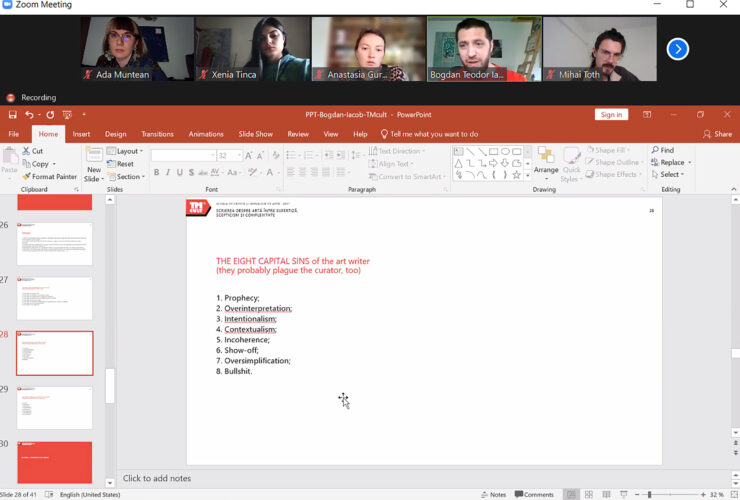
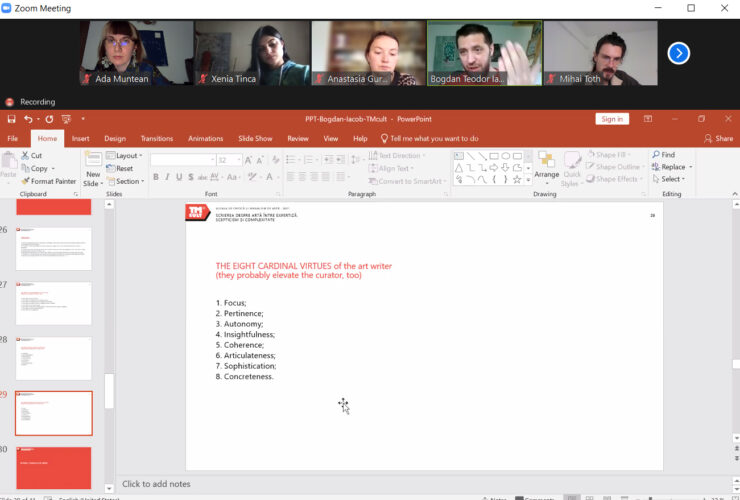
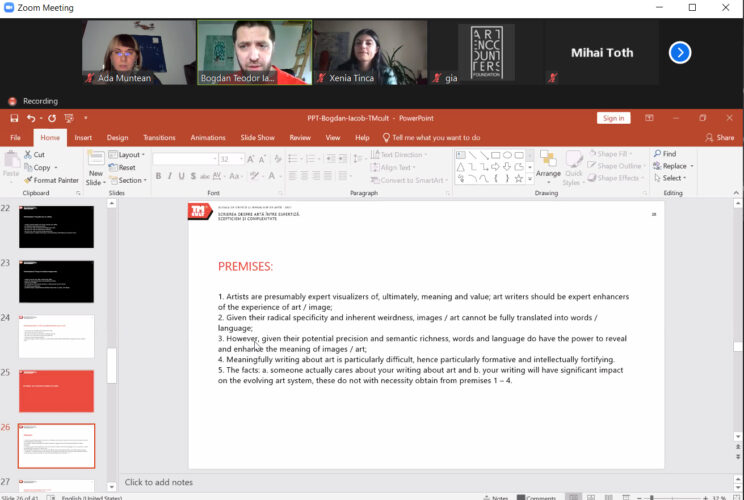
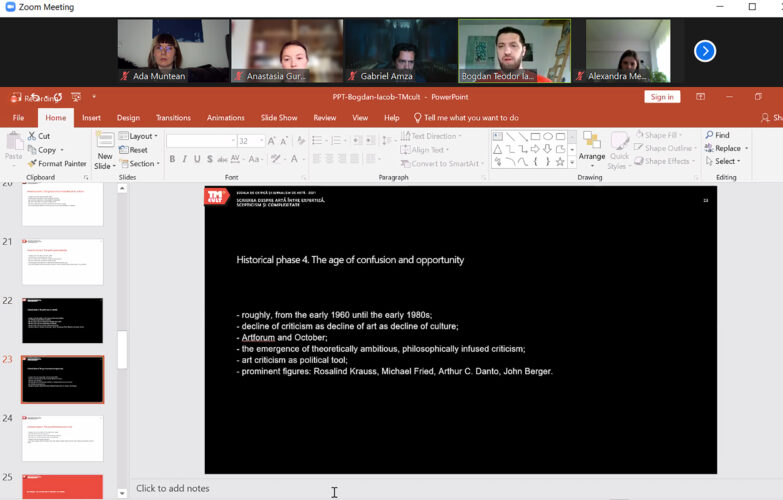
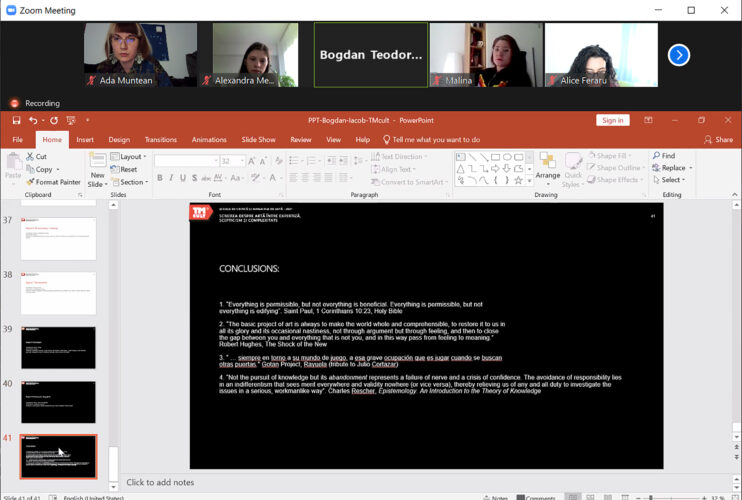
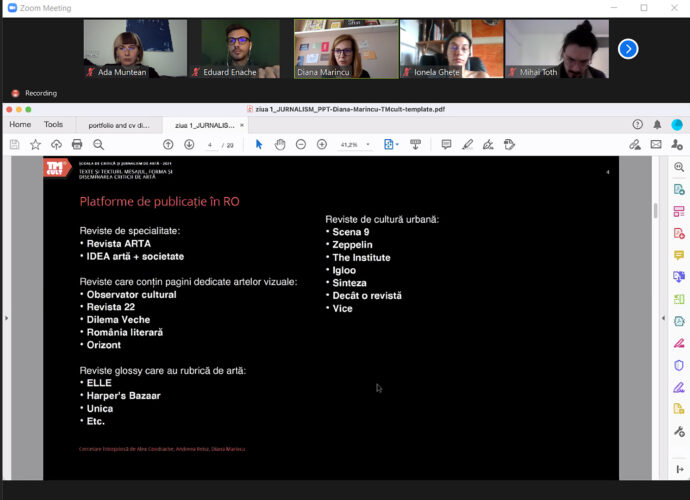
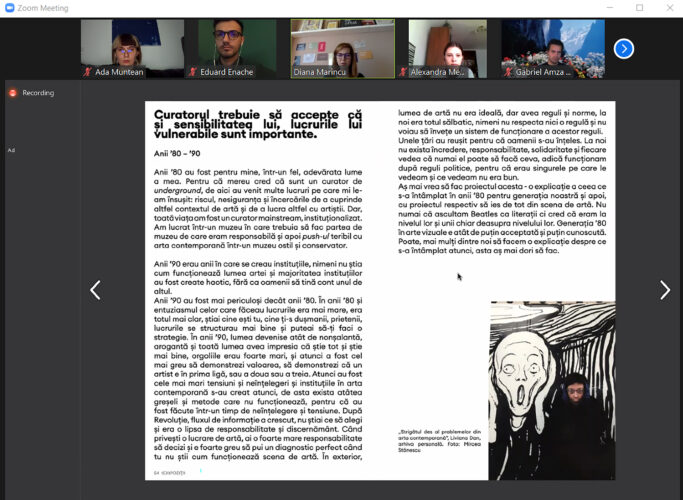
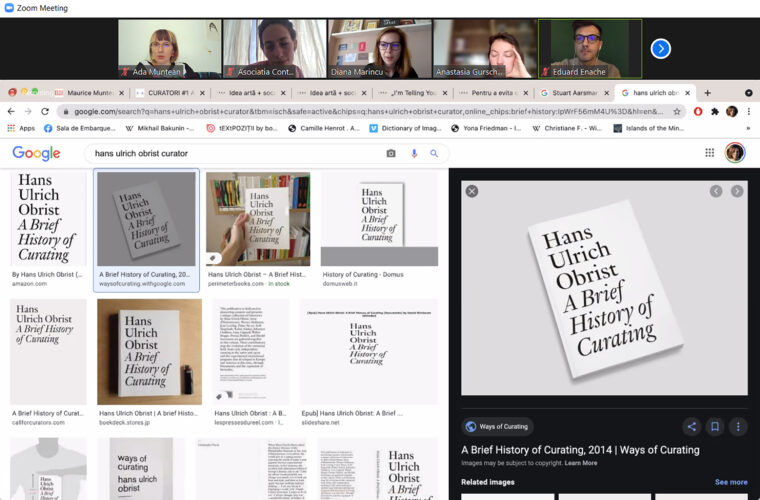
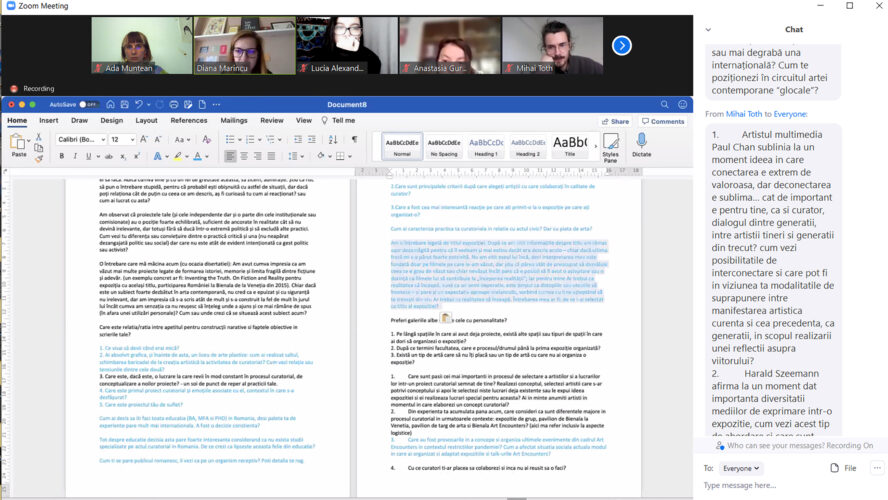
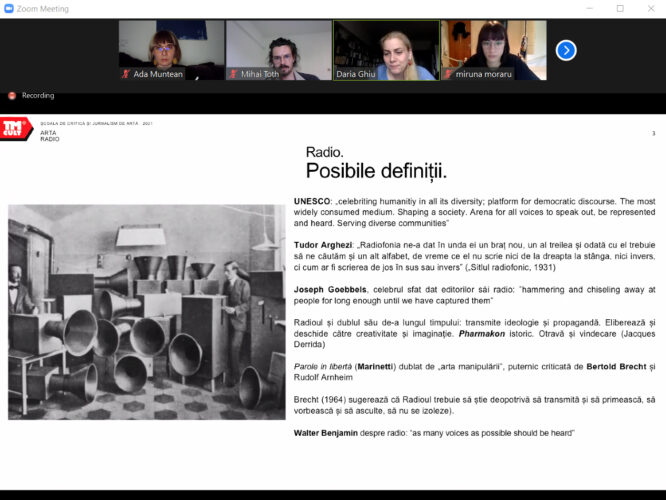
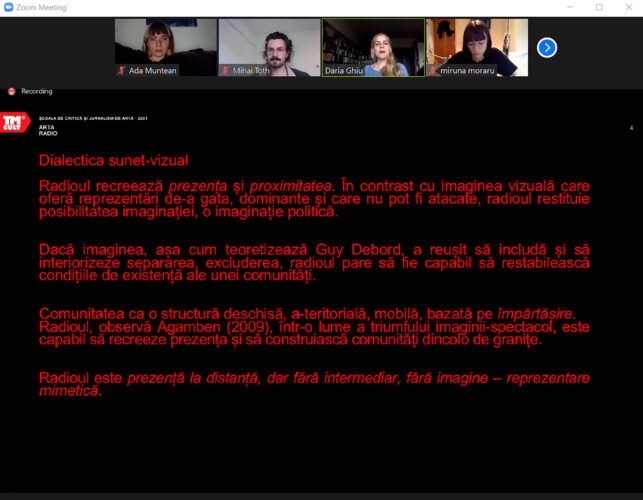
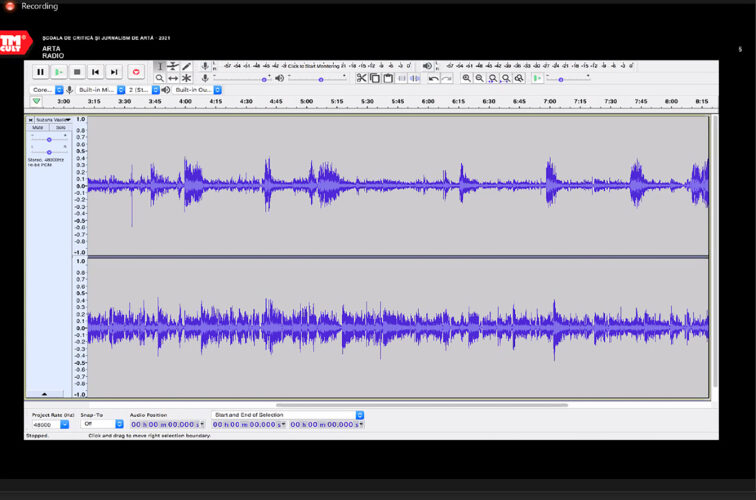
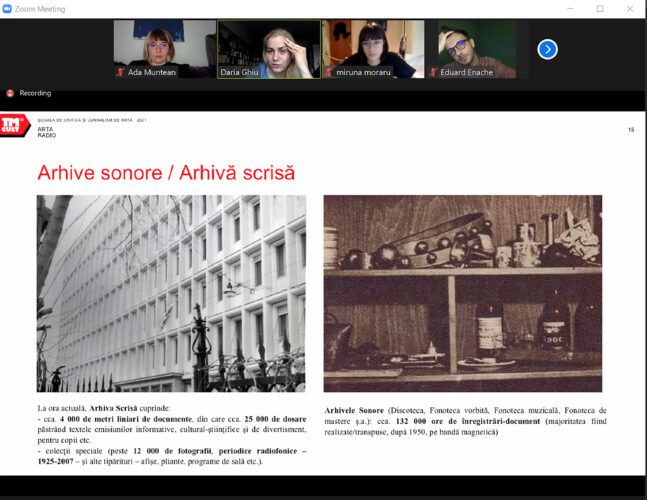
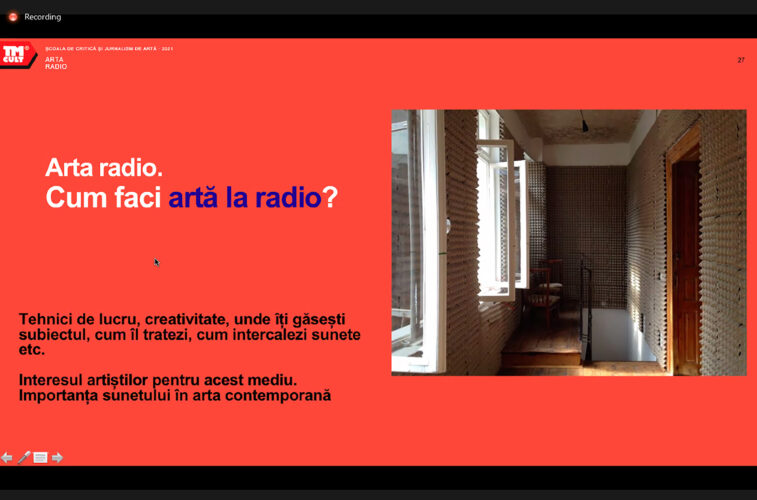
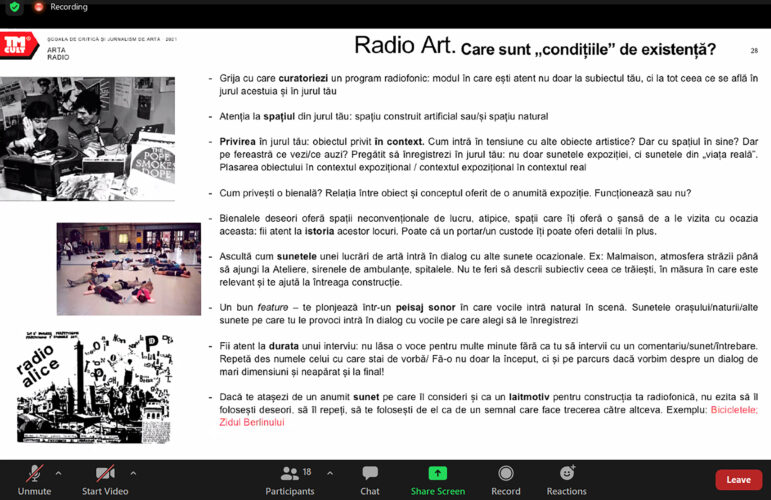
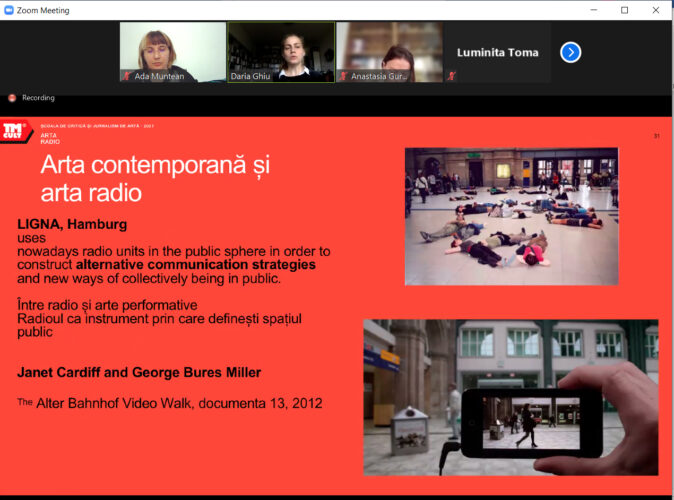
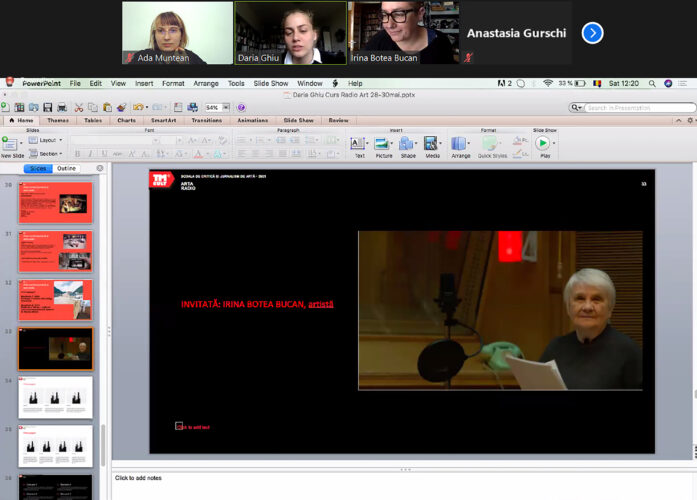
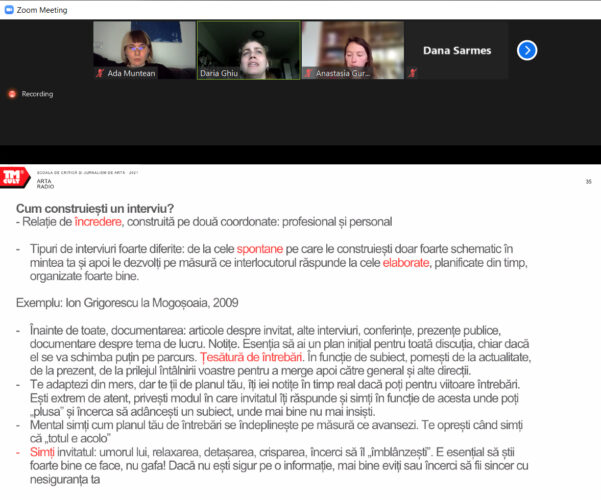
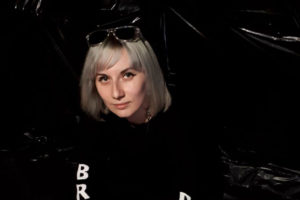
Comments are closed here.